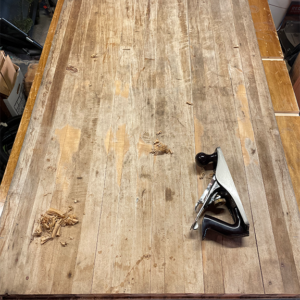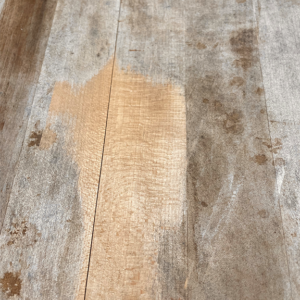Bought a roughly 3′ x 6′ slab of maple work table surface from a farmer on Craigslist.
It shows potential, but I have a few questions on how to best go about the process of preparing it for a desk surface.
On the underside (originally the top), it is cupped badly in spots from use – the farmer told me at one point it was used in a pizza shop. What is the best way to level this irregular surface out for attaching modern-style metal legs that span the width? What should I use to fill in minor cracks between boards? And finally, what kind of finish would you use on this? I’m thinking a couple coats of oil-based polyurethane, but am open to suggestions.
Have included a few images. Was pleasantly surprised at the look of the maple once the patina was removed.
Thanks for any insight you may provide.
















Replies
Hand-planes, including a long jointer hand-plane if you have it, is my guess for leveling. I'd probably go with poly after testing to see if it's not to plastic looking.
I have done similar but mine was not as bad. We used it for years as an island top in the kitchen. I used a oil based poly and it has held up very well.
Is that top laminated in thickness? One side shows very narrow boars, the other has wider parts.
The maple top is sitting on an old wooden outfeed table...
Ah. Then the second picked is zoomed way in. Got it.
Save some work and keep some character... level out only what you need to for attaching your legs. The age and patina tell a nice story and your pizza shop will disappear with the surface.
Without knowing what your legs are I would guess at an approach using a router along the lines of a slab flattening sled.
Very good advice - leveled just what I needed, and the patina looks great.
You won't get it flat with a #4. You need at least a 6.
Best way to do this is a router sled and planer bit.
Thank you- I'm in the process of buying the planes I need. The router sled option is probably the best - am looking into building one.
To the finish, I made two desktops each with water base poly and wax. I found over a few years they got quite dirty from forearms resting on them.
I’m not sure if it was the wax or the poly. I’m guessing the wax. It wasn’t easy to clean and ended up with clear plastic desk pads.
A third desk I used shellac and it held up very well over 20 years of daily use. No wax.
I’m in a basement shop so tend to avoid really smelly finishes hence the WB Poly and shellac.
Lately I have used Armr Seal on two projects, one a dining table with near daily use and it’s held up well and I like the look. It doesn’t meet my ideal “no smell “ requirement but it isn’t too offensive, and I’m starting to choose it for most any horizontal surface that sees more than light use.
Test on the maple. Oil base poly will add amber tones. Water base will add almost none. It depends on how much of the wood color you want to keep.
Mike
I recently delivered a 3’ X 7’ table top made of laminated maple like yours. I first split it in two through the middle so I could plane and joint each half and I glued them back together taking care to have a even thickness and sanded the glue line away.
Very nice. My shop is still developing... don't have a planer yet. But soon.
Here's the final product... I made the top surface as flat as possible using a mixture of a hand plane and a powered plane. I filled in the cracks with tinted wood filler (Durham). Put an 1/8" roundover on the top edges. Sanded it well, then put on 3 coats of polyurethane (Minwax wipe-on). Got the legs from a supplier online. My son loves it.
Very nice. It turned out great! Thanks for checking back.
Nice desk! Thanks for closing the loop, always nice to see the results.
This forum post is now archived. Commenting has been disabled